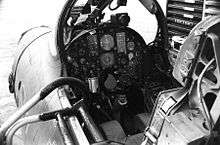Gerald Gustafson
Gerald Gustafson (born September 14, 1928) was a pilot after the post-war period of the United States. His most notable achievements came during the Vietnam War, where he was awarded the Air Force Cross.
Gerald Gustafson | |
|---|---|
Gerald Gustafson with great-grandson, Shaye Gustafson in 2009. | |
| Nickname(s) | Gus |
| Born | September 14, 1928 St. Peter, Minnesota |
| Allegiance | |
| Service/ | |
| Years of service | 1950–1978 |
| Rank | Colonel |
| Battles/wars | Vietnam War |
| Awards | Air Force Cross |
Early life
Gustafson was born in St. Peter, Minnesota in 1928. His grandparents were Swedish immigrants and his father, Herbert C. Gustafson was an artilleryman in France during World War I. Both parents were offspring of Swedish immigrants. In the early part of his life he lost the tip of his right index finger in a farming accident. Later on his flying career was almost ended because the Air Force considered it a "missing digit" but later changed its classification to a "terminal digit."
Air Force Service
Gustafson initially joined the Air Force in 1950 and after completing basic training in Texas was trained in the use of bombardier equipment on the B-26. After completing his training and missing service in the Korean War, he was approved for a new pilot program and trained in Piper Cubs and T-6 Texans. He received advanced fighter training in the P-80 Shooting Star.
After his officer and flight training, Gustafson was stationed in Wisconsin; Thule, Greenland; Texas; and California. During this time he flew F-86D Sabres, F-102s, and F-106 Delta Darts.
Immediately before his Vietnam service, he was cross trained in the F-105 Thunderchief out of Nellis AFB. After his service in Vietnam, he flew F-105s out of Okinowa.

Air Force Cross
Gerald Gustafson won the Air Force Cross, the second highest award for gallantry in the United States Air Force, during the Vietnam War.[1] He flew F-105 Thunderchiefs from Takhli Royal Thai Air Force Base in Thailand and was shot down on two occasions.
He was awarded the medal in November, 1967. His citation noted that "The President of the United States of America, authorized by Title 10, Section 8742, United States Code, awards the Air Force Cross to Major Gerald C. Gustafson for extraordinary heroism in military operations against an opposing armed force as an F-105 Aircraft Commander over North Vietnam on November 19, 1967. On that date, Major Gustafson's aircraft was severely damaged by a surface-to-air missile while he was assisting another pilot who had received battle damage and had been wounded. Major Gustafson refused to leave his comrade until other escort aircraft could be vectored in to give the wounded pilot assistance in reaching his home base safely. Only then, did Major Gustafson egress to a safer area where he was forced to eject from his own stricken aircraft. Through his extraordinary heroism, superb airmanship, and aggressiveness, Major Gustafson reflected the highest credit upon himself and the United States Air Force." [2][3][4]
Gustafson along with Lieutenant Colonel Robert W. Smith and Major Bruce Stocks all received Air Force Crosses for the same mission on November 19, 1967.
Post-Air Force

After Vietnam, Gustafson was put off of flying duty due to an injury which left his eye unable to dilate properly. He was transferred first to attend at the National War College, then worked at the Pentagon. He retired with the rank of Colonel in 1979 to New Richland. Gustafson is actively involved in the VFW, the Red River Valley Fighter Pilots Association, and the Air Force Association. He often speaks to students and classes about his experiences.[5]
References
- "Air Force Cross Medal". VietnamUnitMemorialDisplay.org. Archived from the original on 2008-12-01.
- "The Air Force Cross in Vietnam". HomeOfHeroes.com. Archived from the original on 2006-08-29.
- "Citations-Recipients of the Air Force Cross". HomeOfHeroes.com. Archived from the original on 2017-07-02. Retrieved 2009-10-29.
- "Legion of Valor". legionofvalor.com. Archived from the original on 2013-01-28.
- ""The Aquin," November 2005" (PDF). St. Thomas University.